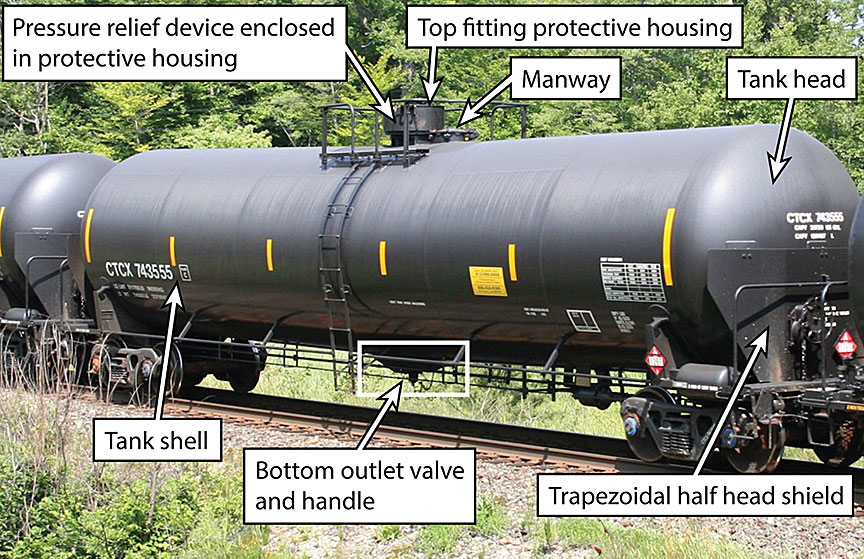Information about tank cars that carry flammable liquids
The occurrence
On 14 February 2015, a Canadian National Railway (CN) crude oil unit train was proceeding eastward on CN's Ruel Subdivision near Gogama, Ontario. The train was equipped with 2 head-end locomotives hauling 100 Class 111 tank cars loaded with petroleum products (Class 3 flammable liquids). Specifically, 68 cars were carrying Petroleum Crude Oil (UN 1267) and 32 cars were carrying Petroleum Distillates (UN 1268). The train was 6089 feet long and weighed 14 355 tons. These Class 111 tank cars were built to the CPC-1232 standard (see Figure 1).
At about 23:50, while travelling at 38 mph, the train crew felt a heavy tug on the train and a train-initiated emergency brake application occurred near Mile 111.7. Subsequently, the crew observed a fire about 10 cars behind the locomotives, so they detached the locomotives from the train. The temperature at the time was −31°C and the maximum permitted track speed was 40 mph.
This accident occurred on an isolated stretch of rail in Northern Ontario. Twenty-nine (29) tank cars of petroleum crude oil derailed, and 19 were breached, releasing about 1.7 million litres of product. The crude oil ignited, and the resulting fires burned for 5 days.
The occurrence train was designated as a "Key Train" operating on a "Key Route".
A "key train" is a train that includes:
- one or more tank cars of dangerous goods loaded with either toxic gases (Class 2.3 Transportation of Dangerous Goods (TDG) Regulations) or products that are toxic by inhalation (Special Provision 23 of the TDG Regs); or
- any combination of 20 or more loaded tank cars and/or intermodal portable tanks containing dangerous goods, as defined in the Transportation of Dangerous Goods Act, 1992.
A "key route" is:
- any track on which, over a period of one year, a railway carries any combination of 10,000 or more loaded tank cars or loaded intermodal portable tanks containing dangerous goods.
There were no injuries reported, and no evacuation was required. The product in several cars was allowed to burn for five days. All fires were extinguished by 20 February 2015.
Standards for tank cars used in the transportation of Class 3 flammable liquids
The following table outlines the features of the standards for Class 111 and TC-117 tank cars used for the transportation of Class 3 flammable liquids.
| Requirements | Older legacy Class 111Note de bas de page 1 | Class 111 CPC 1232 compliant | New TC/DOT 117Note de bas de page 2 | |
|---|---|---|---|---|
| Non-jacketed and non-insulated | Jacketed and insulated | |||
| Head shields | No | Half | Full | Full |
| Top-fitting protection | Optional | Mandatory | Mandatory | Mandatory |
| Thermal protection and jacketed | Optional | Optional | Optional | Mandatory |
| Normalized steelNote de bas de page 3 | Optional | Mandatory | Mandatory | Mandatory |
| Thickness and type of steel (minimum) | 11.1 mm (7/16 inch) | 11.1 mm (7/16 inch) thick TC128-B or 12.7 mm (1/2 inch) in ASTM A516-70 |
11.1 mm (7/16 inch) thick TC128-B or 12.7 mm (1/2 inch) in ASTM A516-70 |
14.3 mm thick (9/16 inch) in TC128-B |
| Performance standards for thermal protection, head and shell puncture resistance | No | No | No | Yes |
| Enhanced performance standard for bottom outlet valves | No | No | No | Yes |
